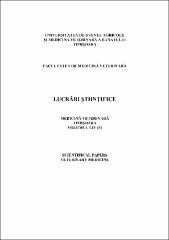| dc.contributor.author | Bojkovski, Jovan | |
| dc.contributor.author | Đedović, S. | |
| dc.contributor.author | Vujanac, Ivan | |
| dc.contributor.author | Prodanović, R. | |
| dc.contributor.author | Nedić, S. | |
| dc.contributor.author | Arsić, S. | |
| dc.contributor.author | Zdravković, N. | |
| dc.contributor.author | Pavlović, I. | |
| dc.contributor.author | Prodanov-Radulović, Jasna | |
| dc.contributor.author | Bojkovski, D. | |
| dc.contributor.author | Becskei, Zsolt | |
| dc.contributor.author | Borozan, S. | |
| dc.date.accessioned | 2021-10-12T07:36:01Z | |
| dc.date.available | 2021-10-12T07:36:01Z | |
| dc.date.issued | 2021 | |
| dc.identifier.issn | 1221-5295 | |
| dc.identifier.uri | https://repo.niv.ns.ac.rs/xmlui/handle/123456789/421 | |
| dc.description.abstract | The presence of chemical environmental pollutants (heavy metals) and their influence on
health status of farm animals has been study in long period. We monitored the influence of
chemical pollutants on rodents leaving on farms. Heavy metals has special danger for leaving
systems, which react with organic molecules to change their structures and function. Heavy
metals enter the body through respiratory system, digestive system and skin. The results of
our many years of research indicate that there is danger of contamination of animal feed with
heavy metals and their position in their body of animals, as well as a negative effect on the
reproductive capacity of domestic animals. Heavy metal toxicity general leads to the formation
of free radicals, inhibiting the activity of antioxidant defense enzymes as well as glutathione
oxidation and the formation malonyl dialdehyde (MDA) as a marker of oxidative stress. Their
toxicity stems from the tendency to form covalent bonds with sulfhydryl groups of
biomacromolecules or displace certain cofactors, there by inhibiting the activity of certain
enzymes. Our recommendation for industrial type farms is to reduce the risk of heavy metals.
To introduce multilevel monitoring of the quality of raw materials and final products, as well as
to apply adequate protectors against the toxic effect of these agents. | en_US |
| dc.description.sponsorship | The study was supported by the Ministry of Education, Science and Technological Development of the Republic of Serbia (Contract number 451-03- 9/2021-14/200143). | en_US |
| dc.language.iso | en | en_US |
| dc.source | Lucrari Stiintifice medicine veterinara, Timisora | en |
| dc.subject | farm animals | en_US |
| dc.subject | rodents | en_US |
| dc.subject | chemical contamination | en_US |
| dc.title | Environmental influence of chemical contaminants on farm animals and rodents (review research) | en_US |
| dc.type | Article | en_US |

